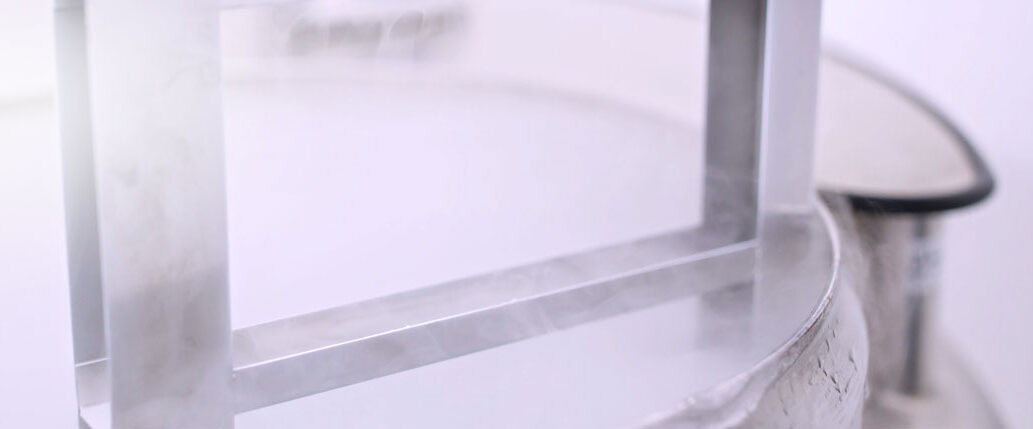Cryopreserved Vials Storage and Thawing Protocol

- AllCells® cryopreserved cell products are delivered in dry ice to maintain the frozen state of the cell product.
- Upon arrival, check vial(s) for loose caps or any other physical defects.
- When handling or transferring frozen cell products, it is important to keep the vials completely frozen and to avoid transient warming events. Do not expose the vial to ambient temperature (20 – 25°C). Transient warming events may affect cell viability and/or function after thawing.
- Products should be used immediately or stored in vapor phase of a liquid nitrogen storage tank.
- We recommend using our Thawing protocol (web link) to properly thaw and wash the cryopreserved cell product prior to your downstream application and use.
- Cryopreserved products should be counted immediately after thawing before any further manipulation. Discovery is not liable for any cell loss during subsequent processing or manipulation.
WARNING: Do not store AllCells® frozen cell products in the liquid phase of liquid nitrogen (LN2). Liquid can enter closed screw top cryovials, which then have the potential to explode when removed from storage.
Storage Precautions
If AllCells® products are stored in liquid phase of LN2, -80°C, or -20°C, it will void any warranty of the product.
Laboratory personnel should use extreme caution when storing samples in LN2. LN2 storage consists of a liquid phase and a gaseous. If cryovials are immersed in the liquid phase, LN2 can enter the closed screw-top cryovials during storage. The cryovial may then explode when it is removed from storage due to the vaporization and expansion (700x expansion ratio) of the liquid nitrogen inside the cryovial.
General instructions
- Frozen cells should be kept on dry ice until ready for thawing.
- Recommended media for diluting and washing cells are RPMI 1640, IMDM, or DMEM supplemented with 10% heat inactivated FBS warmed to room temperature (20-25°C).
- Proper aseptic technique should be used when handling and manipulating cells.
- Cryopreserved products should be counted immediately after thawing before any further manipulation. Discovery is not liable for any cell loss during subsequent processing or manipulation.
Thawing Instructions
- Check that the vial is tightly capped and place in a 37oC water bath.
- Gently swirl the vial until only a small ice crystal remains.
- Remove the vial from the water bath, wipe the outside of the vial with 70% ethanol, and transfer into a biosafety cabinet.
- Gently transfer the entire contents of the vial into a tube containing thawing media.
- The amount of media will depend on the downstream cell counter being used. We recommend at least an equal volume of thawing media be used to dilute out the cryopreservative. For higher cell concentrations, more media might be required.
- Use 1mL of fresh thawing media to rinse the vial and add to the tube with the cells.
- Immediately count the sample.
- Prior to the initiation of any downstream assays, we recommend centrifuging the cells to remove all remaining cryopreservative.
Health Hazards of Liquid Nitrogen
Liquid nitrogen has a 700x expansion ratio, which may cause physical hazards and injuries from the explosion of cryovials, containers, equipment, or other devices. Extensive tissue damage or burns can result from exposure to LN2 or cold nitrogen vapors. Asphyxiation may result from the displacement of oxygen in the air with nitrogen to levels where there is insufficient oxygen. Inhalation of oxygen deficient air can cause dizziness, nausea, vomiting, loss of consciousness, and death.
Personal Protective Equipment
The following personal protective equipment is encouraged when handling or using LN2:
Cryo gloves/Waterproof thermal insulated gloves
- Hands should be protected with waterproof thermal insulated gloves that can be quickly removed if LN2 is spilled on them. Cryo gloves are not intended for submerging hands into LN2.
Lab coats
- Body must be protected with pants, lab coats, and closed-toe shoes.
Safety goggles
- Eyes are sensitive to the extreme cold of LN2 and its vapors. Over-pressurization may result in the explosion of improperly stored cryovials. Chemical splash goggles should be used when handling LN2 and when handling cryovials and other sealed containers that have been stored in LN2.
Safety Precautions
We use cryovials that are designed for vapor phase liquid nitrogen storage.
If long-term storage in the LN2 liquid phase is required, do not use the cryovials provided by us.
Use either:
- Manufacturer-approved cryovials, specifically designed for liquid phase storage.
- Gaseous phase-approved screw-top cryovials that are then hermetically sealed in an outer protective envelope designed for use in LN2.
The handling of cryovials inside of Biological Safety Cabinets or Chemical Hoods (with the sash lowered) will further reduce the risk of injury from explosions caused by excess pressure within the vial.
Limited Warranty: AllCells warranty of frozen cell products for a period of 1 year form the date of receipt if stored properly.
References
Cryovial: Simport T310 Cryovial®
For more information regarding cryovials, please visit Simport http://www.simport.com/
For more information on AllCells® products, please contact us at orders@allcells.com
CAUTION
AllCells® RUO products are “For Research Use Only.” In compliance with U.S. Food and Drug Administration (FDA) Regulations, these products are not intended for use in clinical diagnostic procedures nor in therapeutic procedures.
These products must be:
- Treated as potentially contaminated biological specimens even if available serological reports are negative.
- Handled by establishing or following appropriate safety control procedures to ensure the safety of using these products.
How can we help you?
